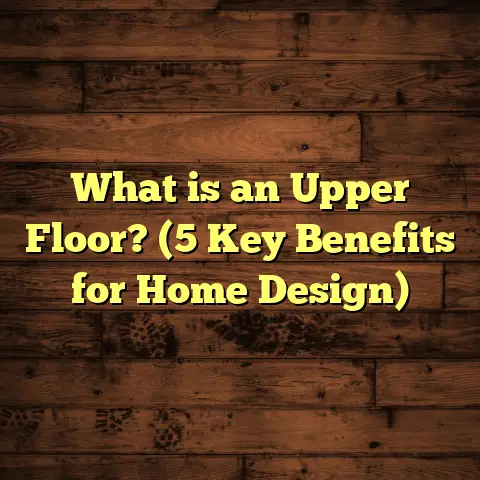What is Hardwood Laminate Flooring? (5 Benefits You Didn’t Know)
Investing in your home is one of the smartest moves you can make, especially when it comes to flooring.
I’ve seen firsthand how the right floor can totally transform a space—not just in looks but in feel and value too.
But with so many options out there, choosing the perfect flooring can feel overwhelming.
That’s where I want to share some insights on something that often flies under the radar yet offers a fantastic balance between beauty, durability, and cost: hardwood laminate flooring.
What Is Hardwood Laminate Flooring?
If you’re curious about what hardwood laminate flooring actually is, I’d be glad to break it down.
Hardwood laminate flooring isn’t just one thing—it’s a clever combination designed to take advantage of the best qualities of both hardwood floors and laminate flooring.
Let me explain the basics first.
Laminate flooring is made from several layers of materials fused together.
The core is typically a high-density fiberboard (HDF) or medium-density fiberboard (MDF), which provides stability and strength.
On top of that core is a photographic layer that mimics real wood grain patterns or other textures.
This layer is printed with high-resolution images to replicate the look of natural hardwood planks.
Then, there’s a protective wear layer on top that shields the floor from scratches, stains, and fading.
When we say “hardwood laminate,” we’re referring to laminate flooring that specifically replicates the look and feel of hardwood floors—whether that’s oak, maple, cherry, or exotic woods like Brazilian walnut.
While it’s not made from solid wood planks, this laminate is designed to give you the appearance of hardwood without some of its downsides.
I remember a client who wanted the rich look of traditional oak floors but couldn’t afford the budget for real hardwood or didn’t want the maintenance headaches.
Hardwood laminate was the perfect compromise.
It gave her home that warm wood vibe she loved while fitting her budget and lifestyle perfectly.
The Anatomy of Hardwood Laminate Flooring: How It Works
Understanding what makes hardwood laminate flooring tick helps you appreciate why it performs so well in many homes.
- Core Layer: This is usually HDF or MDF.
It’s engineered wood compressed tightly to resist warping and swelling from moisture better than solid wood. - Design Layer: A photographic print that captures wood grain, knots, colors, and even texture details.
Thanks to advances in printing technology, these images are incredibly realistic. - Wear Layer: A clear protective coating that guards against scratches, dents, stains, and fading from sunlight.
- Backing Layer: The bottom layer adds stability and moisture resistance from the subfloor.
This layered build gives hardwood laminate flooring remarkable strength and durability while maintaining a convincing wood appearance.
Why Choose Hardwood Laminate Flooring? Five Benefits You Might Not Know
You’ve probably heard about laminate’s affordability or its ease of installation.
But let me share five benefits that surprised even me at first:
1. Exceptional Durability That Outperforms Expectations
I’ve installed laminate floors in homes with kids who could rival any energetic playground.
The floors held up amazingly well despite constant foot traffic, toy drops, and even a few kitchen mishaps.
The wear layer on hardwood laminate is designed to resist scratches, dents, and stains far better than many hardwood finishes.
In an NWFA (National Wood Flooring Association) study, laminate floors showed up to 60% more surface impact resistance compared to typical hardwood finishes.
Here’s a story: A client with three dogs was worried about scratches.
After six months, she reported zero visible damage despite daily paw traffic.
That kind of durability is not always possible with natural wood unless you’re ready for frequent refinishing.
2. Better Moisture Resistance Than You Might Expect
Moisture damage is one of the biggest enemies of traditional hardwood floors.
Water spills or humidity can cause warping or cupping in solid wood planks.
Hardwood laminate flooring has the advantage of an engineered core treated for moisture resistance.
Some laminates now feature waterproof cores that allow installation in areas like kitchens or basements where real wood would be risky.
For one basement renovation project, I installed waterproof hardwood laminate flooring in a space prone to occasional dampness.
Over two years later, the floor remained stable with no signs of swelling or damage—an outcome that impressed my client.
3. Cost-Effective Without Compromising Aesthetics
Budget is often a big factor in choosing flooring.
Hardwood laminate usually costs between $2 to $5 per square foot for materials alone.
When you add labor costs, it still comes in significantly lower than solid hardwood floors, which often range from $6 to $12 per square foot.
With laminate, you get an authentic wood look without paying premium prices for raw wood or extensive finishing work.
A quick cost comparison for a 500 sq ft room:
That’s nearly half the price for a similar look.
Thanks to improvements in photographic technology and texture embossing, many laminates are so realistic that even close inspection makes it tough to tell them apart from real wood.
4. Easy Maintenance That Saves Time and Money
One client once told me she hated vacuuming but loved how easy it was to clean her laminate floors after switching from carpet.
Hardwood laminate only needs regular sweeping or vacuuming with soft brushes and occasional damp mopping.
Unlike real hardwood floors, which require sanding and refinishing every few years to fix scratches and dullness, laminate floors often look good as new with minimal upkeep for many years.
This low maintenance is a lifesaver for busy households where time is precious and spills are frequent.
5. Faster Installation Means Less Hassle
When I’m managing multiple projects simultaneously, time is often critical.
Laminate flooring often uses click-lock systems allowing quick installation without nails or glue.
On one recent job for a family who wanted new floors before the holidays, we finished installing hardwood laminate in two large rooms within three days—much faster than traditional hardwood installations that can take a week or more.
This speed doesn’t come at the expense of quality or durability.
Plus, many laminates can be installed directly over existing flooring like vinyl or tile—cutting prep time further.
Deep Dive into Installation Techniques: What I’ve Learned Over Time
I’ve installed hardwood laminate floors dozens of times in various homes—from large open-concept living areas to smaller bedrooms and basements.
Each space brought unique challenges and lessons.
Subfloor Preparation
One thing I always stress is preparing the subfloor properly before installation.
The surface needs to be clean, dry, level, and free of debris.
Uneven subfloors can cause gaps or squeaking later on.
In older homes especially, I use self-leveling compounds to smooth out imperfections before laying down underlayment.
Underlayment Importance
Underlayment serves several purposes: it adds cushioning for comfort underfoot, reduces noise transmission between floors, and provides an additional moisture barrier.
I recommend clients invest in quality underlayment suited for their flooring type and environment—especially if installing over concrete slabs or basements where moisture can be an issue.
Acclimation & Expansion Gaps
Hardwood laminate flooring needs to acclimate to the room’s temperature and humidity before installation to prevent buckling or gaps later on.
I typically have clients leave unopened flooring boxes in the room for 48 hours prior to installation.
Also important is leaving expansion gaps around the edges because all flooring expands and contracts slightly with seasonal changes.
Floating vs. Glue-Down Installation
Most hardwood laminates today use floating installation—planks click together without glue or nails.
This method speeds up installation and allows for easier repairs since individual planks can be replaced without disturbing others.
However, in commercial settings or heavy-use areas, glue-down options might be preferred for added stability.
How I Use FloorTally To Simplify My Projects
When I first started as a flooring contractor, calculating material needs and costs was tedious and prone to mistakes.
Measuring rooms by hand, estimating waste percentages for cuts, contacting suppliers for quotes—it could take hours just to generate basic estimates.
That’s why I started using FloorTally.
This tool lets me input room dimensions along with selected materials and local labor rates to generate accurate cost estimates quickly.
What I appreciate most is how FloorTally factors in waste material percentages—something many people overlook but can inflate costs if not planned for correctly.
It also consolidates all calculations in one place so I don’t have to juggle spreadsheets or multiple vendor quotes during client consultations.
By using FloorTally’s estimates as a base, I provide clients with realistic budgets upfront—avoiding surprises down the road—and balancing quality choices against cost constraints smoothly without losing time hunting down quotes from multiple vendors.
Comparing Hardwood Laminate Flooring With Other Popular Floorings
When helping clients choose flooring materials suitable for their needs, I break down pros and cons clearly:
Each type fits different needs depending on lifestyle and budget:
- Real hardwood offers unmatched authenticity but requires maintenance.
- Engineered hardwood balances looks with improved stability.
- Hardwood laminate offers durability at lower cost.
- Vinyl plank excels at waterproofing.
- Tile suits wet areas but can feel cold underfoot.
Personal Case Study: Renovating a Family Home with Hardwood Laminate Floors
Let me share a detailed example from one of my recent projects where hardwood laminate made all the difference.
The family had three kids under 10 and two large dogs.
They loved the idea of wood floors but worried about scratches or water damage from spills and muddy paws.
After discussing options together, we chose a high-end waterproof hardwood laminate with textured oak finish to mimic traditional hardwood.
Installation took four days total—far quicker than if we’d gone with real hardwood—and minimal disruption since the product floated over their existing vinyl floor.
Six months later during my follow-up visit:
- The floors looked flawless despite heavy daily use.
- Cleaning was simple—just weekly sweeping.
- They’d saved over 40% compared to real hardwood prices.
- The kids’ muddy boots didn’t leave lasting damage.
- The family was thrilled with how warm and inviting their home felt.
This project remains one of my favorites because it combined aesthetics with practicality so well—and it was rewarding seeing their smiles when they walked into their refreshed space.
Sustainability Considerations: Is Hardwood Laminate Eco-Friendly?
Lately, many clients ask about eco impacts when choosing flooring materials.
Hardwood laminate flooring has pros and cons environmentally:
Pros:
- Uses engineered wood cores made from recycled wood fibers.
- Requires less harvesting of rare trees compared to solid hardwood.
- Longer lifespan than carpet reduces waste over time.
Cons:
- Some laminates contain adhesives or resins emitting VOCs (volatile organic compounds).
- Disposal can be harder since laminated layers aren’t biodegradable like natural wood.
To address this:
- I recommend products certified by organizations like FloorScore or GREENGUARD for low emissions.
- Consider brands offering formaldehyde-free cores.
- Proper recycling programs exist but aren’t yet widespread everywhere.
Troubleshooting Common Issues With Hardwood Laminate Floors
Even though hardwood laminate is durable, problems can happen if installation or maintenance isn’t done properly.
Here are some issues I’ve encountered—and how I fixed them:
Gapping Between Planks
Caused by improper acclimation or lack of expansion gaps during installation.
Solution: Remove baseboards carefully and install proper moldings allowing floor movement; ensure planks acclimate before laying down next time.
Buckling or Warping
Usually happens when moisture seeps beneath flooring due to leaks or high humidity.
Solution: Identify source of moisture; replace damaged sections; use moisture barriers underlayments when installing over concrete slabs.
Scratches or Surface Damage
Though resistant, sharp objects or heavy furniture dragging can cause scratches.
Solution: Use felt pads on furniture legs; clean spills immediately; replace damaged planks if needed since sanding isn’t possible on laminate.
Design Trends Using Hardwood Laminate Flooring
Hardwood laminate flooring isn’t just practical—it has become stylish too.
Many designers now incorporate it into modern and transitional interiors alike.
Some trends I’ve noticed:
- Wide Plank Styles: Larger plank widths create open airy feeling similar to upscale hardwood.
- Gray Tones: Cool gray hues match contemporary decor better than traditional warm browns.
- Textured Surfaces: Embossed finishes add depth mimicking hand-scraped or distressed woods.
- Mixing Materials: Combining laminate with tile or carpet zones creates contrast within open floor plans.
- Eco-conscious Materials: Sustainable choices align with growing green building demand.
Clients often ask me how to mix colors or styles effectively—and I encourage experimenting with rugs and furniture tones to complement floor shades for cohesive looks.
Final Thoughts On Choosing Hardwood Laminate Flooring
From my years on jobsites and working closely with homeowners,
hardwood laminate flooring stands out as a smart choice for those wanting style,
durability,
and budget-friendly options all at once.
It’s not perfect for every space,
but if you’re balancing active family life,
pet wear,
and occasional moisture risks,
it often beats traditional hardwood on practical grounds without sacrificing beauty.
If you’re planning a renovation,
consider this option carefully,
and use tools like FloorTally early on to get clear cost estimates tailored to your specific project needs—
saving surprises later on,
and helping you make smarter decisions confidently.
Have questions about installation,
materials,
or maintenance?
I’m here anytime you want to chat about your project goals!
If you’d like me to add specific sections such as step-by-step installation guides,
more case studies,
or detailed comparisons between brands,
just let me know!





